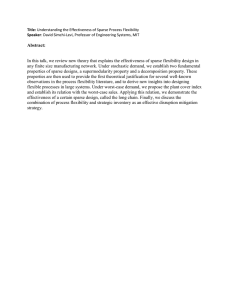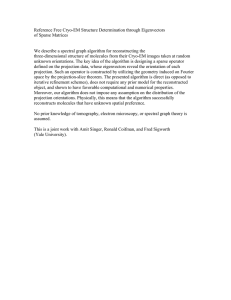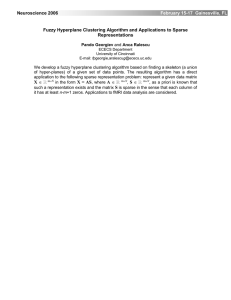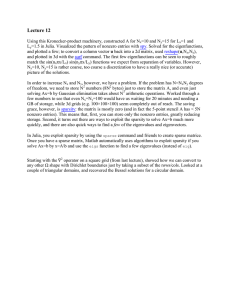Lecture slides
advertisement
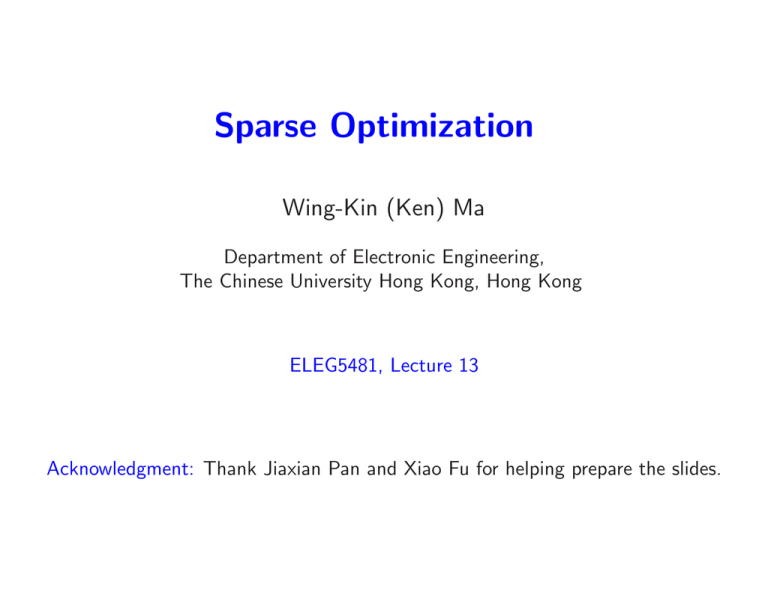
Sparse Optimization
Wing-Kin (Ken) Ma
Department of Electronic Engineering,
The Chinese University Hong Kong, Hong Kong
ELEG5481, Lecture 13
Acknowledgment: Thank Jiaxian Pan and Xiao Fu for helping prepare the slides.
Introduction
• In signal processing, many problems involve finding a sparse solution.
–
–
–
–
–
–
–
–
–
–
compressive sensing
signal separation
recommendation system
direction of arrival estimation
robust face recognition
background extraction
text mining
hyperspectral imaging
MRI
...
1
Single Measurement Vector Problem
• Sparse single measurement vector (SMV) problem: Given an observation
vector y ∈ Rm and a matrix A ∈ Rm×n, find x ∈ Rn such that
y = Ax,
and x is sparsest, i.e., x has the fewest number of nonzero entries.
• We assume that m ≪ n, i.e., the number of observations is much smaller than
the dimension of the source signal.
2
measurements
sparse signal
nonzero entries
3
Sparse solution recovery
• We try to recover the sparsest solution by solving
min kxk0
x
s.t. y = Ax
where kxk0 is the number of nonzero entries of x.
• In the literature, kxk0 is commonly called the “ℓ0-norm”, though it is not a
norm.
4
Solving the SMV Problem
• The SMV problem is NP-hard in general.
• An exhaustive search method:
– Fix the support of x ∈ Rn, i.e., determine which entry of x is zero or non-zero.
– Check if the corresponding x has a solution for y = Ax.
– By solving all 2n equations, an optimal solution can be found.
• A better way is to use the branch and bound method. But it is still very
time-consuming.
• It is natural to seek approximate solutions.
5
Greedy Pursuit
• Greedy pursuit generates an approximate solution to SMV by recursively building
an estimate x̂.
• Greedy pursuit at each iterations follows two essential operations
– Element selection: determine the support I of x̂ (i.e. which elements are
nonzero.)
– Coefficient update: Update the coefficient x̂i for i ∈ I.
6
Orthogonal Matching Pursuit (OMP)
• One of the oldest and simplest greedy pursuit algorithm is the orthogonal
matching pursuit (OMP).
• First, initialize the support I (0) = ∅ and estimate x̂(0) = 0.
• For k = 1, 2, . . . do
– Element selection: determine an index j ⋆ and add it to I (k−1).
r (k) = y − Ax̂(k−1)
(Compute residue r (k)).
j ⋆ = arg min kr (k) − aj xk2 (Find the column that reduces residue most)
j=1,...,n
x
I (k) = I (k−1) ∪ {j ⋆}
(Add j ⋆ to I (k))
– Coefficient update: with support I (k), minimize the estimation residue,
x̂(k) = arg
max
x:xi =0, i∈I
/ (k)
ky − Axk2.
7
ℓ1-norm heuristics
• Another method is to approximate the nonconvex kxk0 by a convex function.
min kxk1
x
s.t. y = Ax.
• The above problem is also known as basis pursuit in the literature.
• This problem is convex (an LP actually).
8
Interpretation as convex relaxation
• Let us start with the original formulation (with a bound on x)
min kxk0
x
s.t. y = Ax,
kxk∞ ≤ R.
• The above problem can be rewritten as a mixed Boolean convex problem
min 1T z
x,z
s.t. y = Ax,
|xi| ≤ Rzi, i = 1, . . . , n
zi ∈ {0, 1}, i = 1, . . . , n.
9
• Relax zi ∈ {0, 1} to zi ∈ [0, 1] to obtain
min 1T z
x,z
s.t. y = Ax,
|xi| ≤ Rzi, i = 1, . . . , n
0 ≤ zi ≤ 1, i = 1, . . . , n.
• Observing that zi = |xi|/R at optimum , the problem above is equivalent to
min kxk1/R
x,z
s.t. y = Ax,
which is the ℓ1-norm heuristic.
• The optimal value of the above problem is a lower bound on that of the original
problem.
10
Interpretation via convex envelope
• Given a function f with domain C, the convex envelope f env is the largest
possible convex underestimation of f over C, i.e.,
f env (x) = sup{g(x) | g(x′) ≤ f (x′), ∀ x′ ∈ C, g(x) convex}.
• When x is a scalar, |x| is the convex envelope of kxk0 on [−1, 1].
• When x is a vector, kxk1/R is convex envelope of kxk0 on C = {x | kxk∞ ≤ R}.
11
ℓ1-norm geometry
(A)
(B)
• Fig. A shows the ℓ1 ball of some radius r in R2. Note that the ℓ1 ball is “pointy”
along the axes.
• Fig. B shows the ℓ1 recovery problem. The point x̄ is a “sparse” vector; the line
H is the set of x that shares the same measurement y.
12
ℓ1-norm geometry
• The ℓ1 recovery problem is to pick out a point in H that has the minimum ℓ1
norm. We can see that x̄ is such a point.
• Fig. C shows the geometry when ℓ2 norm is used instead of ℓ1 norm. We can
see that the solution x̂ may not be sparse.
13
Recovery guarantee of ℓ1-norm minimization
• When ℓ1-norm minimization is equivalent to ℓ0-norm minimization?
• Sufficient conditions are provided by characterizing the structure of A and the
sparsity of the desirable x.
|aT
a |
maxi6=j kaiki2kajj k2
– Example: Let µ(A) =
which is called the mutual coherence.
If there exists an x such that y = Ax and
µ(A) ≤
1
2kxk0 −1 ,
then x is the unique solution of ℓ1-norm minimization. It is also the solution
of the corresponding ℓ0-norm minimization.
– Such mutual coherence condition means that sparser x and “more
orthonormal” A provide better chance of perfect recovery by ℓ1-norm
minimization.
• Other conditions: restricted isometry property (R.I.P.) condition, null space
property, ...
14
Recovery guarantee of ℓ1-norm minimization
There are several other variations.
• Basis pursuit denoising
min kxk1
s.t. ky − Axk2 ≤ ǫ.
• Penalized least squares
min kAx − bk22 + λkxk1 .
• Lasso Problem
min kAx − bk22
s.t. kxk1 ≤ τ.
15
Application: Sparse signal reconstruction
• Sparse signal x ∈ Rn with n = 2000 and kxk0 = 50.
• m = 400 noise-free observations of y = Ax, where Aij ∼ N (0, 1).
30
30
20
20
10
10
0
0
−10
−10
−20
−20
−30
0
500
1000
Sparse source signal
1500
2000
−30
0
500
1000
1500
2000
Perfect recovery by ℓ1 -norm minimization
16
30
30
20
20
10
10
0
0
−10
−10
−20
−20
−30
0
500
1000
Sparse source signal
1500
2000
−30
0
500
1000
1500
2000
Estimated by ℓ2 -norm minimization
17
• Sparse signal x ∈ Rn with n = 2000 and kxk0 = 50.
• m = 400 noisy observations of y = Ax + ν, where Aij ∼ N (0, 1) and
νi ∼ N (0, δ 2).
• Basis pursuit denoising is used.
√
2
• δ = 100 and ǫ = mδ 2.
20
20
15
15
10
10
5
5
0
0
−5
−5
−10
−10
−15
−20
0
500
1000
Sparse source signal
1500
2000
−15
0
500
1000
1500
2000
Estimated by ℓ1 -norm minimization
18
20
25
20
15
15
10
10
5
5
0
0
−5
−5
−10
−10
−15
−15
−20
−20
0
500
1000
Sparse source signal
1500
2000
−25
0
500
1000
1500
2000
Estimated by ℓ2 -norm minimization
19
Application: Compressive sensing (CS)
• Consider a signal x̃ ∈ Rn that has a sparse representation x ∈ Rn in the domain
of Ψ ∈ Rn×n (e.g. FFT and wavelet), i.e.,
x̃ = Ψx.
where x is sparse.
The pirate image x̃
The wavelet transform x
20
• To acquire information of the signal x, we use a sensing matrix Φ ∈ Rm×n to
observe x
y = Φx̃ = ΦΨx.
Here, we have m ≪ n, i.e., we only obtain very few observations compared to
the dimension of x.
• Such a y will be good for compression, transmission and storage.
• x̃ is recovered by recovering x:
min kxk0
s.t. y = Ax,
where A = ΦΨ.
21
Application: Total Variation-based Denoising
• Scenario:
– We want to estimate x ∈ Rn from a noisy measurement xcor = x + n.
– x is known to be piecewise linear, i.e., for most i we have
xi − xi−1 = xi+1 − xi ⇐⇒ −xi+1 + 2xi − xi+1 = 0.
– Equivalently, Dx is sparse, where
−1 2
1 0 ...
0 −1 2 1 . . .
D=
..
..
..
..
..
.
. . . . . . −1 2 1
• Problem formulation: x̂ = arg minx kxcor − xk2 + λkDxk0.
• Heuristic: change kDxk0 to kDxk1.
22
Source
5
0
−5
0
200
400
600
800
1000
1200
1400
1600
1200
1400
1600
Corrupted by noise
5
0
−5
0
200
400
600
800
1000
Original x and corrupted xcor
23
x̂ with λ = 0.1
5
0
−5
0
200
400
600
800
1000
1200
1400
1600
1200
1400
1600
1200
1400
1600
x̂ with λ = 1
5
0
−5
0
200
400
600
800
1000
x̂ with λ = 10
5
0
−5
0
200
400
600
800
1000
Denoised signals with different λ’s and by x̂ = arg minx kxcor − xk2 + λkDxk1.
24
x̂ with λ = 0.1
5
0
−5
0
200
400
600
800
1000
1200
1400
1600
1200
1400
1600
1200
1400
1600
x̂ with λ = 1
5
0
−5
0
200
400
600
800
1000
x̂ with λ = 10
5
0
−5
0
200
400
600
800
1000
Denoised signals with different λ’s and by x̂ = arg minx kxcor − xk2 + λkDxk2.
25
Matrix Sparsity
The notion of sparsity for a matrix X may refer to several different meanings.
• Element-wise sparsity: kvec(X)k0 is small.
• Row sparsity: X only has a few nonzero rows.
• Rank sparsity: rank(X) is small.
26
Row sparsity
• Let X = [x1, . . . , xp]. Row sparsity means that each xi shares the same support.
sparse signal
measurements
nonzero rows
27
Row sparsity
• Multiple measurement vector (MMV) problem
min kXkrow-0
X
s.t. Y = AX,
where kXkrow-0 denote the number of nonzero rows.
• Empirically, MMV works (much) better than SMV in many applications.
28
• Mixed-norm relaxation approach:
min kXkpq,p
X
s.t. Y = AX,
where kXkq,p = (
Pm
i p (1/p)
i=1 kx kq )
and xi denotes the ith row in X.
• For q ∈ [1, ∞] and p = 1, this is a convex problem.
• For (p, q) = (1, 2), this problem can be formulated as an SOCP
min
t,X
m
X
ti
i=1
s.t. Y = AX
kxi k2 ≤ ti, i = 1, . . . , m.
29
• Some variations:
min kXk2,1
s.t. kY − AXkF ≤ ǫ.
min kAX − Y k2F + λkXk2,1
min kAX − bk2F
s.t. kXk2,1 ≤ τ.
• Other algorithms: Simultaneously Orthogonal Matching Pursuit (SOMP),
Compressive Multiple Signal Classification (Compressive MUSIC), Nonconvex
mixed-norm approach (by choosing 0 < p < 1), ...
30
Application: Direction-of-Arrival (DOA) estimation
S2,t
S1,t
Sk−1,t
Sk,t
...
θ2
θk
θk−1
θ1
...
d
Y1,t
Y2,t
...
d
Ym−1,t Ym,t
31
Application: Direction-of-Arrival (DOA) estimation
• Considering t = 1, . . . , p, the signal model is
Y = A(θ)S + N,
where
A(θ) =
1
− j2πd
γ sin(θ1 )
e
..
− j2πd
γ (n−1) sin(θ1)
e
...
1
− j2πd
γ sin(θm )
...
..
e
..
− j2πd
γ (n−1) sin(θm )
... e
Y ∈ Rm×p are received signals, S ∈ Rk×p sources, N ∈ Rm×p noise, m and k
number of receivers and sources, and γ is the wavelength.
• Objective: estimate θ = [θ1, . . . , θk ]T , where θi ∈ [−90◦, 90◦] for i = 1, . . . , k.
32
• Construct
A = [ a(−90◦), a(−89◦), a(−88◦), . . . , a(88◦), a(89◦), a(90◦) ],
− j2πd
γ sin(θ)
where a(θ) = [ 1, e
− j2πd
γ sin(θ) T
,...,e
] .
• By such construction, we have
A(θ) = [ a(θ1), . . . , a(θk ) ],
is approximately a submatrix of A.
• DOA estimation is approximately equivalent to finding the columns of A(θ) in
A.
• Discretizing [−90◦, 90◦] to more dense grids may increase the estimation accuracy
while require more computation resources.
33
• Example: k = 3, θ = [−90◦, −88◦, 88◦].
A
X
[S1,1, . . . , S1,p]
Y =
[S2,1, . . . , S2,p]
...
...
a(−90◦ ) a(−88◦ )
a(88◦ )
[S3,1, . . . , S3,p]
• To locate the “active columns” in A is equivalent to find a row-sparse X.
• Problem formulation:
min kY − AXk2F + λkXk2,1.
X
34
Simulation: k = 3, p = 100, n = 8 and SNR= 30dB; three sources come from
−65◦, −20◦ and 42◦, respectively. A = [ a(−90◦), a(−89.5◦), . . . , a(90◦) ] ∈
Rm×381.
T
True Angle θ=[−65, −20, 42]
Values of |X|
11
10
Corresponding 2−norm of row of X
50
2.5
9
8
100
2
7
150
6
1.5
5
200
4
1
250
3
2
0.5
300
1
0
−80
−60
−40
−20
0
20
Angle (in Degree)
40
60
80
350
10
20
30
40
50
60
70
80
90
100
35
Application: Library-based Hyperspectral Image Separation
36
• Consider a hyperspectral image (HSI) captured by a remote sensor (satellite,
aircraft, etc.).
• Each pixel of HSI is an m-dimensional vector, corresponding to spectral info. of
m bands.
• The spectral shape can be used for classifying materials on the ground.
• During the process of image capture, the spectra of different materials might be
mixed in pixels.
37
• Signal Model:
Y = BS + N,
where Y ∈ Rm×p is HSI with p pixels, B = [b1, . . . , bk ] ∈ Rm×k are spectra of
materials, S ∈ Rk×p
+ , Si,j represents the amount of material i in pixel j, and N
is the noise.
• To know what materials are in pixels, we need to estimate B and S.
38
• There are spectral libraries providing spectra of more than a thousand materials.
Desert Varnish
refectance(%)
Chalcedony
refectance(%)
Buddingtonite
refectance(%)
Andradite
refectance(%)
Amonium Smectite
refectance(%)
refectance(%)
Alunite
Muscovite
refectance(%)
spectral bands
Montmorillonite 2
refectance(%)
spectral bands
Montmorillonite 1
refectance(%)
spectral bands
Kaolinite 2
refectance(%)
spectral bands
Kaolinite 1
refectance(%)
spectral bands
Dumor
refectance(%)
spectral bands
Pyrope
spectral bands
spectral bands
spectral bands
spectral bands
refectance(%)
spectral bands
Paragonite
refectance(%)
spectral bands
Nontronite 4
refectance(%)
spectral bands
Nontronite 3
refectance(%)
spectral bands
Nontronite 2
refectance(%)
spectral bands
Nontronite 1
refectance(%)
spectral bands
spectral bands
spectral bands
Some recorded spectra of minerals in U.S.G.S library.
• In many cases, an HSI pixel can be considered as a mixture of 3 to 5 spectra in
a known library, which records hundreds of spectra.
39
• Example: Suppose that B = [b1, b2, b3] is a submatrix of a known library A.
Again, we have
A
X
[S1,1, . . . , S1,p]
Y =
[S2,1, . . . , S2,p]
...
...
b1
b2
b3
[S3,1, . . . , S3,p]
• Estimation of B and S can be done via finding the row-sparse X.
• Problem formulation:
min kY − AXk2F + λkXk2,1,
X≥0
where the non-negativity of X is added for physical consistency (since elements
of S represent amounts of materials in a pixel.)
40
Simulation: we employ the pruned U.S. Geological Survey (U.S.G.S.) library with
n = 342 spectra vectors; each spectra vector has m = 224 elements; the synthetic
HSI consists of k = 4 selected materials from the same library; number of pixels
p = 1000; SNR=40dB.
Ground truth material indices: [8, 56, 67, 258]
Values of elements of the estimated |X|
8
0.8
7
2−norms of rows of the estimated X
50
0.7
6
0.6
100
5
0.5
150
4
0.4
200
3
0.3
2
250
0.2
1
300
0
50
100
150
200
Index of library spectra
250
0.1
300
10
20
30
40
50
60
70
80
90
100
0
41
Rank sparsity
• Rank minimization problem
min rank(X)
X
s.t. A(X) = Y,
where A is a linear operator (i.e., A × vec(X) = vec(Y ) for some matrix A).
• When X is restricted to be diagonal, rank(X) = kdiag(X)k0 and the rank
minimization problem reduces to the SMV problem.
• Therefore, the rank minimization problem is more general (and more difficult)
than the SMV problem.
42
• The nuclear norm kXk∗ is defined as the sum of singular values, i.e.
kXk∗ =
r
X
σi .
i=1
• The nuclear norm is the convex envelope of the rank function on the convex set
{X | kXk2 ≤ 1}.
• This motivates us to use nuclear norm to approximate the rank function.
min kXk∗
X
s.t. A(X) = Y.
• Perfect recovery is guaranteed if certain properties hold for A.
43
• It can be shown that the nuclear norm kXk∗ can be computed by an SDP
kXk∗ = min
Z1 ,Z2
s.t.
1
2 tr(Z1
Z1
XT
+ Z2 )
X
0.
Z2
• Therefore, the nuclear norm approximation can be turned to an SDP
min
X,Z1,Z2
1
2 tr(Z1
+ Z2 )
s.t. Y = A(X)
Z1 X
0.
X T Z2
44
Application: Matrix Completion Problem
• Recommendation system: recommend new movies to users based on their
previous preference.
• Consider a preference matrix Y with yij representing how user i likes movie j.
• But some yij are unknown since no one watches all movies
• We would like to predict how users like new movies.
• Y is assumed to be of low rank, as researches show that only a few factors affect
users’ preferences.
movies
2
1
Y =
?
?
2
3
?
3
?
?
1
4
1
?
4
?
2
?
3
?
?
?
2
?
?
5
?
2
1
5
5
?
2
users
5
3
45
• Low rank matrix completion
min rank(X)
s.t. xij = yij , for (i, j) ∈ Ω,
where Ω is the set of observed entries.
• Nuclear norm approximation
min kXk∗
s.t. xij = yij , for (i, j) ∈ Ω.
46
Low-rank matrix + element-wise sparse corruption
• Consider the signal model
Y =X +E
where Y is the observation, X a low-rank signal, and E some sparse corruption
with |Eij | arbitrarily large.
3
3
3
3
3
3
3
3
3
3
3
3
3
3
3
3
3
3
3
3
3
3
3
3
3
3
3
3
3
3
3
3
3
3
3
3
3
3
3
3
3
3
3
3
3
3
• The objective is to separate X from E via Y .
47
• Simultaneous rank and element-wise sparse recovery
min rank(X) + γkvec(E)k0
s.t. Y = X + E,
where γ ≥ 0 is used for balancing rank sparsity and element-wise sparsity.
• Replacing rank(X) by kXk∗ and kvec(E)k0 by kvec(E)k1, we have a convex
problem:
min kXk∗ + γkvec(E)k1
s.t. Y = X + E.
• A theoretical result indicates that when X is of low-rank and E is sparse enough,
exact recovery happens with very high probability.
48
Application: Background extraction
• Suppose that we are given video sequences Fi, i = 1, . . . , p.
• Our objective is to exact the background in the video sequences.
• The background is of low-rank, as the background is static within a short period
of time.
• The foreground is sparse, as activities in the foreground only occupy a small
fraction of space.
49
• Stacking the video sequences Y = [vec(F1), . . . , vec(Fp)], we have
Y = X + E,
where X represents the low-rank background, and E the sparse foreground.
• Nuclear norm and ℓ1-norm approximation:
min kXk∗ + γkvec(E)k1
s.t. Y = X + E.
50
√
• 500 images, image size 160 × 128, γ = 1/ 160 × 128.
• Row 1: the original video sequences.
• Row 2: the extracted low-rank background.
• Row 3: the extracted sparse foreground.
51
Low-rank matrix + sparse corruption + dense noise
• A more general model
Y = A(X + E) + V,
where X is low-rank, E sparse corruption, V dense but small noise, and A(·) a
linear operator.
• Simultaneous rank and element-wise sparse recovery with denoising
min rank(X) + γkvec(E)k0 + λkV kF
X,E,V
s.t. Y = A(X + E) + V.
• Convex approximation
min kXk∗ + γkvec(E)k1 + λkV kF
X,E,V
s.t. Y = A(X + E) + V.
• A final remark: In sparse optimization, problem dimension is usually very large.
You probably need fast custom-made algorithms instead of relying on CVX.
52
Reference
S. Boyd, “ℓ1-norm methods for convex-cardinality problems”, lecture note of
EE364b, Standford university.
J Romberg, “Imaging via compressive sensing”, Signal Processing Magazine, 2008.
Y. Ma, A. Yang, and J. Wright, “Sparse Representation and low-rank
representation”, tutorial note in European conference on computer vision, 2012
Y. C. Eldar and G. Kutyniok, “Compressed Sensing: Theory and Applications”,
Cambridge University Press, 2012.
J. Chen and X. Huo, “Theoretical Results on Sparse Representations of MultipleMeasurement Vectors”, IEEE Trans. Signal Process., 2006
D. Malioutov, M. Cetin, and A. Willsky, “A sparse signal reconstruction perspective
for source localization with sensor arrays”, IEEE Trans. Signal Process., 2005.
M.-D. Iordache, J. Bioucas-Dias, and A. Plaza, “Collaborative Sparse Regression for
Hyperspectral Unmixing”, accepted for publication in IEEE Trans. Geosci. Remote
Sens., 2013.
53
